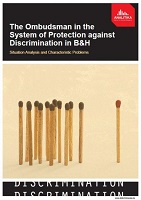The Ombudsman in The System of Protection Against Discrimination in Bosnia and Herzegovina: Situation Analysis and Characteristic Problems
The Ombudsman in The System of Protection Against Discrimination in Bosnia and Herzegovina: Situation Analysis and Characteristic Problems
Author(s): Adrijana Hanušić
Contributor(s): Edin Hodžić (Editor), Kanita Halilović (Translator), Aida Gavrić (Editor)
Subject(s): Criminal Law, International Law, Human Rights and Humanitarian Law, Court case
Published by: Analitika – Centar za društvena istraživanja
Keywords: BiH; Ombudsman institution; human rights; discrimination; protection; situation analysis;
Summary/Abstract: The Law on the Prohibition of Discrimination of Bosnia and Herzegovina (hereinafter referred to as LPD) accords the Ombudsman of B&H the status of “central institution competent for protection against discrimination” and for that purpose prescribes the establishment of a special department with the sole task of considering cases of alleged discrimination committed by any legal or natural person, in any sphere of life. The law envisions a broad spectrum of competences for the Ombudsman, ranging from promotional activities, through surveys in the field of discrimination, to acting on complaints filed by individuals alleging to be victims of discrimination and taking an active role in misdemeanor proceedings for protection against discrimination. In this regard, the legislative competences of the Ombudsman of B&H in the field of protection against discrimination to large extent conform with international standards relevant for the operation of equality bodies. However, for combating discrimination efficiently it is not enough only to adopt legislative solutions harmonized with these standards. The key is to ensure efficient and proper implementation of the Law, which is currently qualified as poor in Bosnia and Herzegovina, primarily through strengthening institutions that are able to respond to the new important task of anti-discrimination protection accorded to them by the Law and through continuous support to their activities by other key actors. At the same time, in light of some existing legislative innovations, it is important at the earliest possible stage of implementation of the Law to ensure a more precise formulation of certain vague or incomplete provisions which provide the framework for the role of the Ombudsman Institution in the system of anti-discrimination protection, to precisely define and strengthen its concrete competences and conduct on particular issues, as well as to urge its maximum internal engagement in dealing with the problem of discrimination in line with generally accepted standards and obligations. In line with that, the goal of this research, along with providing an overview of international standards and comparative practice related to equality bodies, is to identify some of the obstacles that stand in the way of more efficient fulfilment of the Ombudsman’s role in protection of individuals against discrimination, as well as to offer potential solutions for overcoming them. The report is based on an analysis of the legislative framework, available data on the situation in the field of combating discrimination in practice in B&H (such as relevant statistics, information on the course and outcome of individual cases before the Office of the Ombudsman), analysis of relevant recommendations made by the Ombudsman, and interviews with several competent interlocutors. In addition, a comparative survey was carried out with the aim of identifying examples of good practice related to different problem areas and identified obstacles to efficient implementation on the Law on the Prohibition of Discrimination from the perspective of the Institution of the Ombudsman of B&H. Although the countries included in the comparative survey were defined in advance – using as the basic criterion the existence of an Ombudsman or an equivalent institution in the system of protection against discrimination and aiming to encompass primarily European Union countries and countries in the region that share our problems – additional interesting cases were also included if required by a specific aspect of the survey. In this connection, bearing in mind the still insufficient practice in this field, we focused on analyzing structural conditions and processes in which the Ombudsman of B&H is involved in order to identify the fundamental structural obstacles. Based on contextualized analysis and comparative experience, we produced recommendations on how to advance the position and maximize the contribution of the Ombudsman in efficient implementation of the Law on the Prohibition of Discrimination. Bearing in mind the numerous roles accorded to this institution by the Law, we focused on institutional aspects and on the key competence of the Ombudsman in this field – i.e. on fundamental problems and possible solutions related to acting on individual discrimination complaints. It is important to emphasize that the final draft of this publication was sent to a large number of experts, Institution of the Ombudsman of B&H and Serbian Commissioner for Protection of Equality, as well as to a wide circle of relevant actors in this field. Their comments and suggestions were integrated into the final version of the report. The report is structured as follows: relevant international standards related to ombudsman institutions and equivalent equality bodies are presented first. After these introductory considerations, the position and role of the Institution of the Ombudsman of B&H is briefly presented in the context of the Law on Protection against Discrimination of B&H, specifically focusing on the procedure for individual complaints. The third, key part of the report lays out the fundamental legislative, institutional and procedural problems and obstacles that make it difficult for the Ombudsman of B&H to effectively exercise the function of central institution for protection against discrimination in B&H. Recommendations elaborated in detail and aimed at eliminating the identified problems constitute the closing section of this report.
Series: Analitika - Report
- Page Count: 70
- Publication Year: 2012
- Language: English
- Content File-PDF
- Introduction

